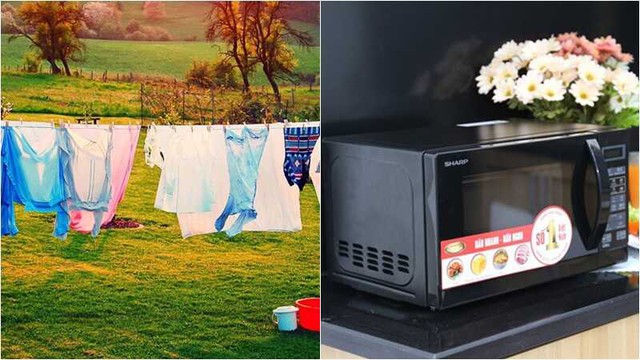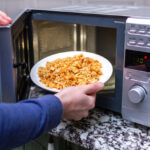Microwave ovens, commonly known as microwaves, are a popular household appliance in many families. With the ability to reheat food, defrost, and cook meals, they save time and make cooking easier. Microwave ovens use electromagnetic waves to heat food.
In addition to its primary function, microwave ovens have numerous other fantastic uses. Let’s explore and make full use of this kitchen appliance.
2. The Main Functions of a Microwave Oven
2.1. Reheating Food
One of the primary functions of a microwave oven is reheating food. It can quickly warm your meals while preserving their delicious flavors and preventing overcooking or burning.
2.2. Cooking Food
Microwave ovens enable you to cook a wide variety of dishes. You can even make sticky rice, cook rice, smoke meat, roast peanuts, prepare soup, and much more while ensuring even cooking. For more meal ideas, you can search online for recipes specifically designed for microwave cooking.

The main functions of a microwave oven include reheating, steaming, defrosting, grilling, and cooking food.
2.3. Defrosting Food
Microwave ovens are excellent for defrosting frozen food items. Simply select the defrost setting, and your food will be ready for further preparation without the risk of bacterial contamination.
2.4. Steaming Food
Microwave ovens use steam generated from the water in the accompanying water compartment to heat and steam-cook your meals. Steamed food retains moisture and is ideal for cooking dishes like steamed buns and dumplings.
2.5. Grilling Food
– Regular Grilling: Microwave ovens with a grilling function use heat emitted from internal heating elements to cook or crisp food.
– Convection Grilling: Convection grilling circulates hot air and maintains a stable temperature, allowing you to cook multiple trays of food simultaneously without the need to flip them midway through cooking. This results in evenly cooked and delicious meals.

Some microwave ovens also feature a combination grilling function.
3. Other Amazing Uses for Your Microwave Oven
In addition to the five main functions mentioned above, there are numerous other fantastic and practical uses for your microwave oven, such as:
3.1. Easier Nut Shelling
Hard-shelled nuts like walnuts or almonds can be a challenge to crack and shell. With your microwave oven, this task becomes much easier. Simply place a cup of water in the microwave, add the nuts, and heat for 5–10 seconds. The shells will soften, making them easier to peel.
3.2. Making Delicious Popcorn
You can make tasty popcorn at home without having to go out or wait too long. Mix a spoonful of butter with a cup of dried corn kernels in a bowl, cover, and place in the microwave. Set the power level to around 600W (Medium-High) and wait for about 3 and a half minutes.

One fantastic use of the microwave oven is its ability to make delicious popcorn.
3.3. Easier Garlic Peeling
Place garlic cloves and cloves in the microwave for about 20 seconds, and their skins will come off effortlessly without leaving any odor on your hands.
3.4. Reviving Stale Bread
Wrap a stale loaf of bread in a damp cloth and microwave it for 10 seconds to restore its freshness. You can also use this trick to enhance the crispness of fried bread.
3.5. Disinfecting Wooden Cutting Boards
Wooden cutting boards are essential kitchen tools, but they can harbor bacteria, especially when they get damp and moldy. To disinfect your wooden cutting board, rub it with lemon or a mixture of vinegar and salt, then place it in the microwave for 2–3 minutes.
3.6. Drying Herbs
Instead of letting leftover parsley or basil go to waste, dry them in your microwave. Place the herbs on a paper towel and microwave for about 30 seconds. Your dried herbs will last for up to a year.
3.7. Quick-Drying Socks and Clothes
During rainy or humid seasons, it can be challenging to dry socks and clothes. Your microwave oven can help! Place the damp items in the microwave for 2–5 minutes, and they’ll be ready to wear.

The microwave oven can quickly dry socks and clothes when needed.
3.8. Preserving Fresh Flowers
You can use your microwave oven to dry and preserve your favorite flowers in just a few minutes. Place the flowers in the microwave with a desiccant like silica gel.
3.9. Disinfecting and Deodorizing Sponges
After prolonged use, sponges can develop an unpleasant odor. Soak the sponge in a mixture of water and white vinegar or lemon juice, then place it in the microwave for a minute at a high temperature. This will effectively disinfect and deodorize the sponge.
3.10. Juicing Oranges and Lemons
Oranges and lemons straight out of the refrigerator can be challenging to juice, and the amount of juice extracted is often less. To make juicing easier and yield more juice, place the fruits in the microwave for 30 seconds to 1 minute.

Microwaving oranges and lemons for 30 seconds to 1 minute will make them easier to juice and yield more liquid.
3.11. Liquifying Honey
Honey tends to crystallize and harden when stored in the refrigerator. To return it to its liquid state, place the container of honey in the microwave for about 15 minutes at a medium temperature setting.

Microwaving crystallized honey for 15 minutes at a medium temperature will restore its liquid consistency.
3.12. Warming Beauty Products
Your microwave oven can enhance your beauty routine by warming hair oil treatments and moisturizing face masks, allowing the nutrients to penetrate your skin more effectively. Set the temperature to medium and heat the products for 10–20 seconds before use.
3.13. Quick-Soaking Beans
Microwave ovens can significantly reduce the time needed to soak beans. If you forgot to soak your beans beforehand, simply place them in a bowl with baking soda and enough water to cover them. Set the microwave to the highest temperature for 10 minutes, then let the beans sit for 30–40 minutes to cool.
3.14. Tear-Free Onion Chopping
Say goodbye to teary eyes when chopping onions. Cut off both ends of the onion, peel the outer layer, and place the onion in the microwave for 30 seconds. Then, chop the onion as usual, without the stinging sensation.
3.15. Easy Tomato Peeling
To peel tomatoes without squishing them, make a small cross-shaped incision on the skin and place them in the microwave for about 30 seconds. Wait an additional 2 minutes before removing them; the skins will come off effortlessly.

The uses of the microwave oven mentioned in this article are incredibly practical and beneficial for our daily lives.
3.16. Proofing Dough
Traditional dough proofing can take over an hour, but with a microwave oven, it only takes a maximum of 15 minutes. Here’s how: Place the dough in a large bowl, cover it with plastic wrap, and place a glass of water next to it. Set the microwave to the lowest power level and put the dough inside for about 3 minutes. Then, heat it for another 3 minutes and let it rest in the microwave for 6 minutes. Your dough will double in size.
3.17. Melting Chocolate
Instead of spending a lot of time melting chocolate over a double boiler, you can use your microwave oven without worrying about burning it. Place the chocolate in a heat-resistant glass bowl and set the power level to medium (2–2.5) to melt it gently.
3.18. Creating Foam for Beverages
If you’re craving a latte at home, complete with that perfect foam, your microwave oven can help. Fill a jar halfway with your choice of milk, seal it tightly, and shake vigorously for a minute to create foam. Then, place the jar in the microwave for 30 seconds to stabilize the foam for your coffee.
Conclusion
Microwave ovens are incredibly versatile appliances that can do much more than just reheat food. By exploring their various functions, you can save space and get the most out of your kitchen tools. Remember to always refer to the user manual to learn more about your appliances and their capabilities.





































